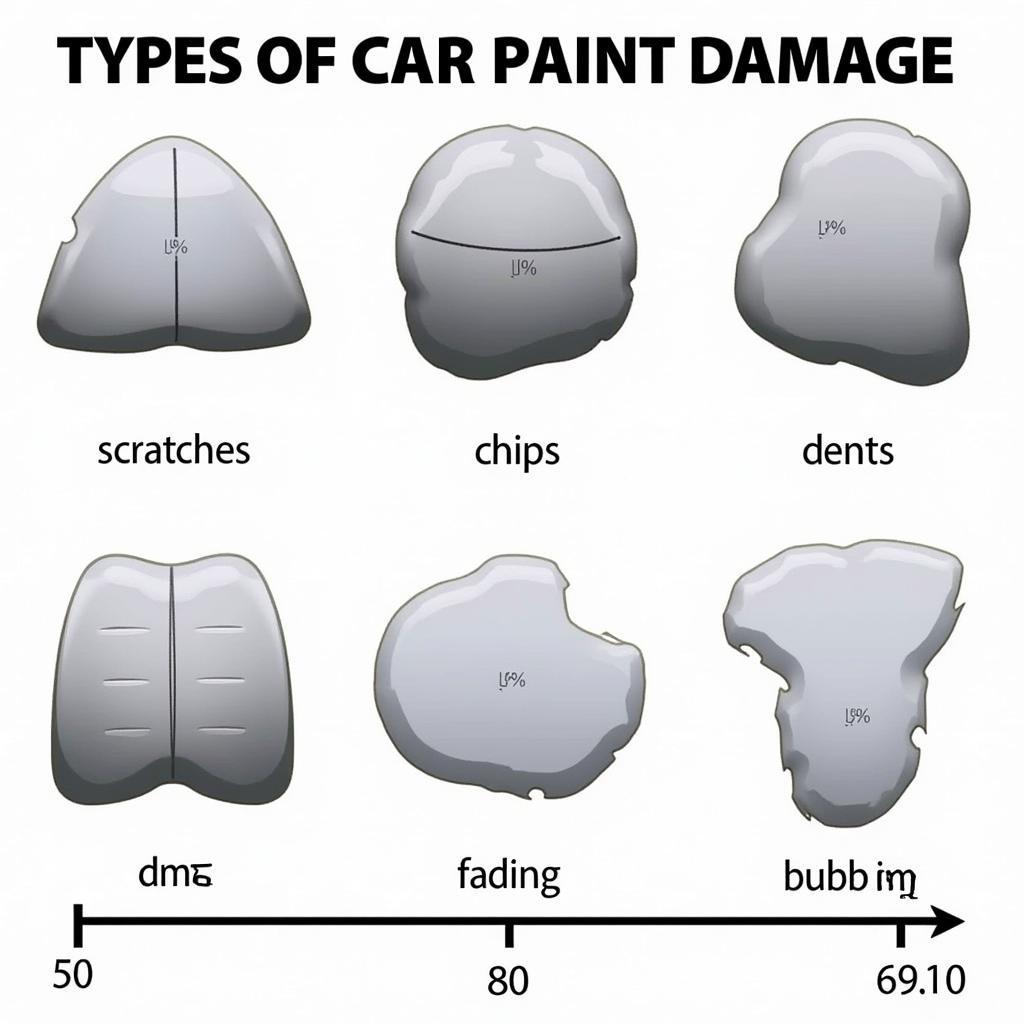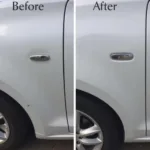Repairing paint on a car is often necessary to maintain its appearance and protect it from further damage. Whether it’s a minor scratch, a deep gouge, or faded paint, understanding the repair process and options available can save you time and money. This guide covers everything you need to know about car paint repair, from DIY fixes to professional solutions.
A key decision in car paint repair is choosing between DIY and professional services. Minor scratches and chips might be manageable at home with touch-up paint and some polishing. However, for more extensive damage, like dents or deep scratches, professional help is recommended for a seamless and lasting repair. For those who are comfortable with minor DIY repairs, learning how to repair paint on car can be a cost-effective solution.
Assessing the Damage: Types of Car Paint Damage
Identifying the type of paint damage is crucial for choosing the appropriate repair method. Common types include:
- Scratches: These range from clear coat scratches to deep gouges that reach the metal.
- Chips: Small pieces of paint chipped off, often caused by rocks or road debris.
- Dents: Deformations in the car’s bodywork that may also involve paint damage.
- Fading: Loss of color vibrancy due to sun exposure or environmental factors.
- Bubbling: Paint lifting or blistering, often indicating rust underneath.
Accurate assessment helps determine whether you can tackle the repair yourself or need car paint repair prices from a professional.
DIY Car Paint Repair: Fixing Minor Imperfections
For minor scratches and chips, DIY repair is a viable option. This usually involves cleaning the area, applying touch-up paint, and sanding/polishing for a smooth finish. It’s essential to match the paint color precisely for a seamless repair.
How to Repair Minor Scratches
- Clean the area with soap and water.
- Apply touch-up paint to the scratch.
- Let the paint dry completely.
- Gently sand the area with fine-grit sandpaper.
- Polish the area with rubbing compound.
While DIY repairs can save money, it’s crucial to manage expectations. Perfect results are difficult to achieve without professional equipment and expertise.
Professional Car Paint Repair: When to Seek Expert Help
For significant damage, like deep scratches, dents, or bubbling paint, professional repair is highly recommended. Professionals have the expertise and equipment to restore your car’s paint to its original condition. They can also address underlying issues like rust, ensuring a long-lasting repair. If you are dealing with bubbling paint, it’s especially important to seek professional help. You can learn more about how to repair bubbling paint car and the associated costs.
Benefits of Professional Repair
- High-quality finish: Professionals use specialized tools and techniques for a flawless result.
- Color matching: They can perfectly match your car’s paint color.
- Rust removal and prevention: They can address underlying rust issues.
- Long-lasting repairs: Professional repairs are more durable and resistant to future damage.
“Addressing rust is critical for preventing further damage,” says renowned auto body specialist, John Miller. “A professional repair ensures proper rust removal and protection, extending the life of your car’s paint job.”
Choosing the Right Repair Method: Factors to Consider
Several factors influence the decision between DIY and professional repair paint on car:
- Extent of the damage: Minor scratches might be suitable for DIY, while deeper damage requires professional attention.
- Your budget: DIY repairs are generally cheaper, but professional repairs offer superior quality.
- Your skill level: DIY requires some level of skill and patience.
- Time commitment: DIY can be time-consuming, while professional repairs are typically faster.
Knowing the cost to repair scratched paint under car can help you make an informed decision. For video tutorials and demonstrations, a youtube car paint scratch repair video can be very helpful.
Conclusion: Maintaining Your Car’s Appearance
Repairing paint on a car is essential for preserving its value and aesthetics. By understanding the different repair options and factors to consider, you can make an informed decision and restore your car’s finish. Whether you opt for a DIY approach or seek professional assistance, addressing paint damage promptly prevents further deterioration and keeps your car looking its best.
FAQ
- Can I repair deep scratches myself? While possible, it’s challenging to achieve a professional finish without experience and specialized tools.
- How do I match my car’s paint color perfectly? Auto parts stores can usually match the color based on your car’s VIN or paint code.
- How long does touch-up paint take to dry? This varies depending on the type of paint and environmental conditions, but typically a few hours.
- How can I prevent car paint damage? Regular washing, waxing, and parking in shaded areas can help protect your car’s paint.
- What is the average cost of professional car paint repair? This depends on the extent of the damage and the shop’s rates, but it can range from a few hundred to several thousand dollars.
- How can I find a reputable car paint repair shop? Ask for recommendations from friends or family, or check online reviews.
- What should I look for in a professional car paint repair estimate? A detailed breakdown of the work involved, including materials and labor costs.
For further assistance, check out our other articles on car maintenance and repair.
Need help with repair paint on car? Contact us via WhatsApp: +1(641)206-8880, Email: [email protected]. Our 24/7 customer service team is ready to assist you.



